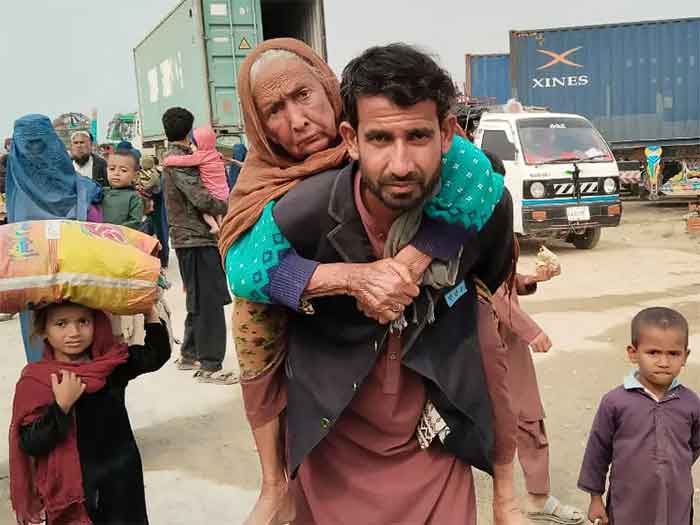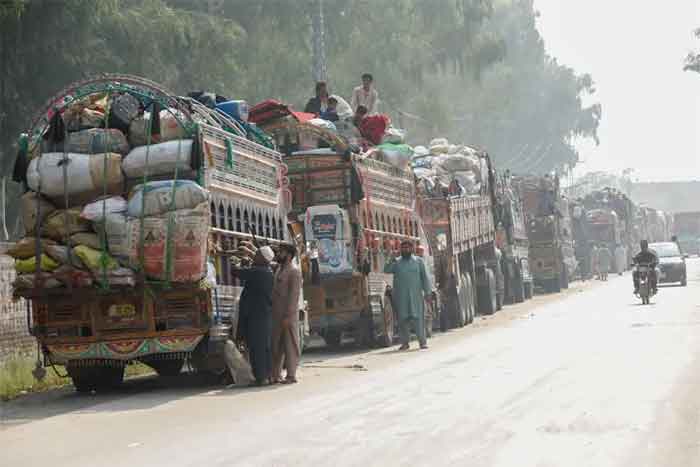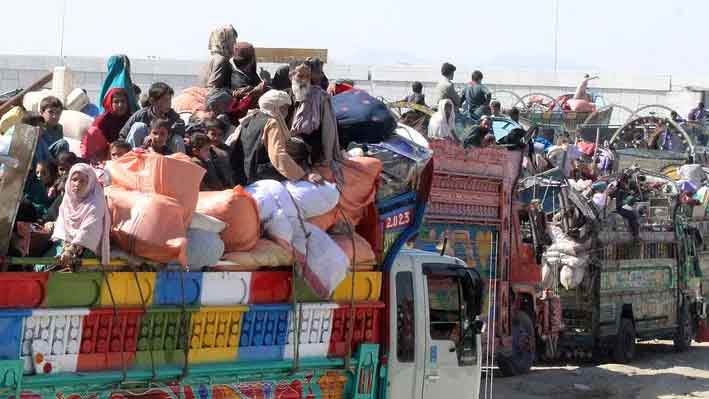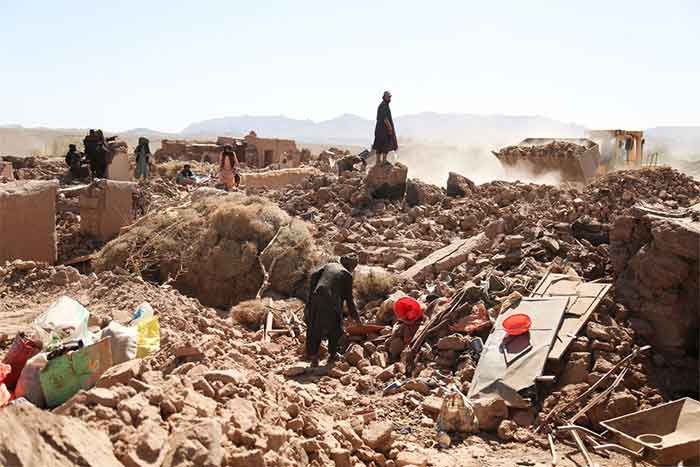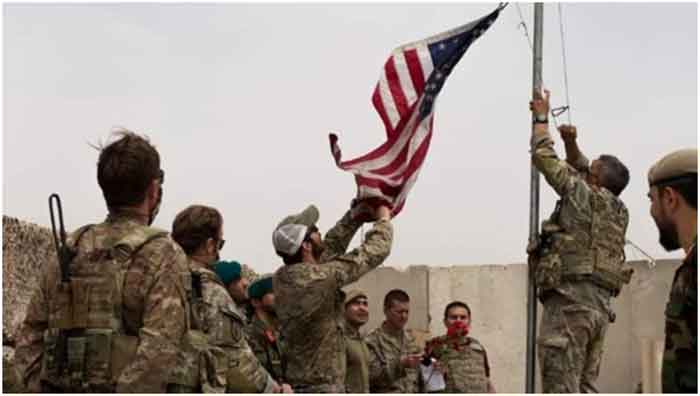
In late April 2021, US President Joe Biden announced a withdrawal from Afghanistan. In other words, the US has been trounced in Afghanistan by its very own jihadist Frankenstein, the Taliban. The defeat of USA is covered with the ugly debris of history. The dirty war on Afghanistan was part of a disastrous process of occupying and controlling large swathes of the world. On September 16, 2001, President George W. Bush vowed to “rid the world of evil-doers,” then cautioned: “This crusade, this war on terrorism, is going to take a while.” The word “crusade” comes from the Latin for the cross, crux, and implies the warlike march of Christianity against the infidel, recalling one of the most shameful blots on the medieval maps of Western imperialism. The new Crusade by the American empire was waged in defense of a different professed faith, not Christianity but rather liberal democracy. But this belief also concealed less noble designs.
Like the original Crusaders, the US and its European partners have been concerned with geopolitical advantage in a strategically important area of the world. For the Crusaders, Jerusalem was an important site of pilgrimage but also a vital trade route. Today’s Crusaders have been more concerned about energy sources, whether the oil of Iraq or the natural gas pipelines that pass through Central Asia. To realize these more mundane goals, the West has made certain tactical alliances with actors in the Muslim world – the Northern Alliance in Afghanistan, Sunni fighters in Iraq, and the illiberal governments of Saudi Arabia, Bahrain, and Yemen. Hard-headed strategies aimed at gaining imperialist dominance translated into the infliction of calculated barbarity upon the people of Muslim majority countries. Slowly and steadily, the Crusade against terrorism spawned the monstrous machine of Islamophobia as the warmongers of the West deployed racist narratives and tropes against Muslims. This ideological idiom of anti-Muslim hatred is historically rooted in the Crusades of the late 11th and 14th centuries.
Emergence of Islam
Islam emerged in the 7th century in the Hijaz region of Arabia, which includes the cities of Mecca and Medina. The area was a major hub for trade activity, and the Arabs who lived there were in constant contact with their Christian Byzantine and Persian Sassanid neighbors. These economic and cultural linkages formed the context in which Prophet Muhammad, a trader by profession, began to devote time to spiritual matters. Prophet Muhammad worked for his wife, whose caravans traded with Syria. It is believed that in the year 610, while Prophet Muhammad was in the hills near Mecca, the angel Gabriel appeared to him to deliver a message from God. Over the course of the next two decades (610-32 CE), Prophet Muhammad had several such revelations, and on that basis he propagated a new religion called Islam. In the beginning there were very few converts to Islam. The people of Mecca greeted Prophet Muhammad with hostility. This was partly due to the welfarist message he preached – God expects people to share their wealth with those needier than them.
In 622, Prophet Muhammad and his followers left Mecca to travel to Medina, a journey referred to as the Hijra. Here, Prophet Muhammad became a spiritual and a political leader, creating a strong and growing community of believers; by the time of his death in 632, Islam had spread beyond the Hijaz and into other parts of Arabia. Within 20 years of Prophet Muhammad’s death in 632, his followers had laid the foundations of the first Islamic empire in the Fertile Crescent. Arab armies not only defeated the Sassanid dynasty (which had ruled Persia and the neighboring regions for centuries) but also took over parts of the Byzantine Empire’s territories. These victories were no doubt possible only because the Persian and Byzantine Empires had been engaged for almost a 100 years in a war that had enfeebled both sides, alienated their populations and opened a possibility of new conquests. Syria and Egypt were part of the Byzantine Empire; Iraq was ruled by Sassanid Persia. All three now fell to the force and ardor of a unified tribal force.
Impressed by these successes, entire tribes adopted the new religion. Mosques began to appear in the desolate deserts, and the army was augmented. Islam’s swift triumphs were seen as a sign that Allah was both omnipotent and on the side of the Believers. The expansion of Islam continued under the Umayyad dynasty (661–750 CE) into North Africa, and then into Europe in the early eighth century. Their conquests began in Spain, continued through the entire Iberian Peninsula (Portugal, and parts of southern France), and reached into Italy. Numerical strength and military strategy only partly accounted for these victories. The ability of the Muslim generals to maneuver their camel cavalry and combine it with an effective guerrilla-style infantry confused an enemy used to small-scale nomadic raids. However, much more important was the active sympathy which a significant minority of the local people demonstrated for the Muslims. A majority remained passive, waiting to see which side would triumph, but they were no longer prepared to fight for or help the old empires.
As the rest of Europe endured a period of cultural stagnation known as the Dark Ages, al-Andalus – as the Iberian Peninsula came to be known under Muslim rule – saw the growth and development of human knowledge. The works of various great societies, from the Greeks to the Persians, were translated into Arabic in the many libraries created by Muslim rulers (not only in al-Andalus but also in Baghdad under the Abbasid dynasty). One great site of learning was Córdoba in Spain. Here, as elsewhere, tremendous advances were made in the fields of philosophy, medicine, astronomy, architecture, and even urban development. While Europe was socially paralyzed, the citizens of Córdoba enjoyed streetlights and running water. Europe finally began the process of moving out of the Dark Ages in the early 12th century, and intellectuals visited the diverse libraries of the Muslim empires to regain lost knowledge. This period saw the retranslation of various works from Arabic back into European languages. Through this process, European intellectuals came to absorb the profound contributions made by Eastern thinkers.
Translated Arabic writings on medicine, mathematics, astronomy and other sciences were for centuries used as textbooks in medieval Europe, while the writings of Muslim philosophers like Ibn Sina (980-1037, known in the West as Avicenna) and Ibn Rushd (1126-98, known as Averroes), and Jewish philosophers who wrote mainly in Arabic like Maimonides (Rabbi Moses ben Maimon, 1135-1204), were eagerly read and discussed and influenced several generations of medieval Christian philosophers and theologians. The period of European intellectual growth in the 11thcentury was accompanied by growth in commerce and trade. Markets and towns began to spring up. At this point, Muslims were one of the major obstacles to European expansion; the pagan raiders (such as the Normans and Magyars) that had relentlessly invaded Christian Europe in the 9th and 10th centuries had been converted and assimilated. The only enemy that remained was the Muslims.
Christian Offensives
Islam became a convenient “other” to mobilize support for the territorial ambitions of different rulers. In Spain, Christian rulers in the north began a war to retake the Iberian Peninsula from the “Muslim enemy” in what came to be known as the Reconquista (reconquest). In the East, the Christian Byzantine Empire (or Eastern Rome) suffered a series of defeats at the hands of the Muslim Seljuq Turks. The emperor wrote to Pope Urban II to seek Europe’s help against the Turks. His call was heeded. On November 27, 1095, Urban launched a holy war (known as the Crusades) and called upon all Christians in Europe to unite and fight against the “enemies of God.” This charge wasn’t simply about religion. For the Pope, the call to the defense of the faith and Jerusalem provided an ideal opportunity to cement the papal authority’s role in legitimating temporal rulers, and to reunite the Eastern (Greek) and Western (Latin) churches. Religion became the screen behind which social and economic conflicts were played out.
European rulers took up the clarion call of the Holy War for multiple reasons. Christian rulers, knights, and merchants were driven by the political, military, and economic advantages that would result from the establishment of a kingdom in the Middle East. Moreover, Europe consisted of a number of rival feudal regimes that constantly fought each other. The Crusades served as a means to reduce this intra-European conflict and to deflect attention onto an external enemy. Using religion to solidify identity and loyalty, the papacy sought to create a united Christian Europe over which it could hold spiritual authority. Those who responded to Urban’s declaration and joined the Crusader armies, however, were motivated by everything – from religious zeal to the rewards of plunder. A great feudal army entered Syria in 1097, captured Antioch in 1098, and then entered Jerusalem. In 1099, after a 40-day siege, the Crusaders took Jerusalem. The scale of the massacre traumatized the entire region.
The killing lasted two whole days at the end of which most of the Muslim population – men, women and children – had been killed. The Jews had fought side by side with the Muslims to defend the city but the entry of the Crusaders created a sense of panic. In remembrance of past ritual, the elders instructed the entire Jewish population to gather in the synagogue and in its surrounds to offer a collective prayer. The Crusaders surrounded the perimeter of the synagogue, set fire to the building and made sure that every single Jew was burnt to death. To maintain their dominance, the Crusaders needed to consolidate their military capabilities. This was accomplished through intensified accumulation. The result was: a) extreme exploitation of the Arab peasantry; and b) routine plundering of trade-caravans. Crusaders’ successes were primarily a result of internecine warfare within the Arab world. Sectarian schisms, notably a 30-year war between the Sunni and Shia factions, had weakened the Islamic camp.
Key rulers, politicians and military leaders on both sides had died in the years immediately preceding the First Crusade. “This year,” the historian Ibn Taghribirdi wrote in 1094, “is called the year of the death of caliphs and commanders.” The deaths sparked off wars of succession in both Sunni and Shia sects, further debilitating the Arab world. These sectarian divisions were exacerbated by the political disunity of the Islamic world. At first, the vast area the Arabs had conquered remained a single geopolitical entity under the Umayyad caliphs of Damascus. But the geography of the new Arab world contained several natural economic units in which separate ruling classes with interests of their own quickly developed. Distance limited the effectiveness of Umayyad rule. Nor was this the only problem. The Umayyads represented the Arab warrior aristocracy who had carried out the initial Islamic conquests and had settled in the ancient cities of Syria.
Their rule was increasingly resented by other sections of the population. The result was a revolution led by Abbasids – the cosmopolitan Persian faction within Islam. Rebels from Iran led by a descendant of the Prophet raised an army, overthrew the Umayyad caliphate, established a new dynasty, and laid down a wider and more secure base for continued Arab rule. However, the victory of the Abbasids disrupted the political cohesion of the Islamic world. During the 9th and 10th centuries, three centers of power emerged: the Abbasid caliph in Baghdad, the Fatimid caliph in Cairo (belonging to the Shia tradition, which claimed descent from the fourth caliph, Ali, and his wife Fatima, the daughter of the Prophet) and the Umayyad caliph in Cordoba, established by the last remaining prince of the Umayyads, Abdel Rahman, who managed to escape to al-Andalus. Conflicts between and within these entities overstrained state power, drained national treasuries, and further weakened the rulers. During the 11th century the Abbasid caliphate effectively collapsed. The caliph’s Seljuk Turkish mercenaries seized power for themselves.
Islamic Resistance: Resurgence and Decline
As the Crusaders incurred the anger of large swathes of Muslim population, the Islamic states began regrouping. Northern Syria and Northern Iraq were united in 1128. Edessa was recaptured and added to the growing Islamic state in 1144. The Second Crusade of 1146-1148, organized in response to the Islamic resurgence, was an utter failure. Damascus and Southern Syria were added to the new state, and the Crusader Principality of Antioch shrank to a small coastal enclave. In 1183, Egypt was merged with the new Syrian super-state. The fusion of Egypt and Syria under the leadership of Saladin, a Kurdish warrior, greatly invigorated Muslim resistance. Saladin answered the Crusade with a call for popular jihad. On July 4, 1187, at the Battle of Hattin, Saladin, at the head of 30,000 men, destroyed the entire army of the Crusader Kingdom of Jerusalem. The recapture of the holy city followed soon after. There was nothing to compare with the wholesale massacres at Antioch and Jerusalem during the First Crusade.
Of the prisoners taken at Hattin, only one was executed (by Saladin himself), along with the Templar and Hospitaller knights, barbaric warriors who had waged a war of bigotry and genocide. Despite further expeditions, the Crusaders never recovered. Though it took a century to complete the process, their castles were reduced one by one, their territory gradually stripped away. Saladin’s victories had temporarily halted the Crusades, but the internal structures of the caliphate were permanently damaged, and new invaders were on the way. A Mongol army from Central Asia led by Hulagu Khan laid siege to Baghdad in 1258, calling on the caliph to surrender and promising that if he did so, the city would be spared. The caliph refused. The Mongol armies carried out their threat, laid waste to the city and executed the last Abbasid caliph. An entire culture perished as libraries were put to the torch.
The inglorious exist of the caliphate segued into the destruction of the Iberian Peninsula. The Christian kingdoms in the north of Spain had already been engaged in a tug-of-war with the southern Moorish states; the religious frenzy of the First Crusade turned this belligerent peace into a full-blown Crusade. In 1085, the city of Toledo in central Spain was taken by the Catholic kings, and by 1250 the Moorish empire was reduced to the emirate of Granada on the coastal strip in the south of Spain. In 1492, Ferdinand and Isabella, the Catholic monarchs of Spain, took control of Granada, thus completing the ethnic cleansing of Muslims and Jews from the Iberian Peninsula. It is important to note that during the period of Muslim rule over the Iberian Peninsula, Christians and Jews were tolerated as “people of the book” and were allowed to practice their religion if they paid a fee.
In the 14th and 15th centuries, as Europe began to come out of the Middle Ages and into the modern era, its relationship with Islam changed. There was a slow abatement in the discursive construction of Islam as an acute threat to the existence of the West. This shift was the result of a number of processes. First, the incomplete project of a united Christian Europe started to break down around this time due to the rise of nationalism. The emergence of proto-nationalist currents internally fragmented Europe and prevented any attempts aimed at forging a common front against Islam. Second, the renaissance of European culture further weakened the authority of the Church. The key source of anti-Muslim religious hatred, the Church, was no longer able to drum up holy wars; the Crusades came to an end. Third, the Mongols had now entered the picture and posed a threat to Europe. This recognition of lands beyond Europe, and of threats beyond the Muslims, put an end to the Manichean division of the world into Christianity and Islam.
The Crusader mentality continued in the 21st as century US Presidents used interventionist tactics in pursuit of the American empire’s economic interests. While Bush considered himself a noble Crusader, Osama bin Laden compared himself to Saladin. As Karl Marx noted, “all great world-historic facts and personages appear, so to speak, twice…the first time as tragedy, the second time as farce.” The dualistic schema of Crusader-Saladin – and the Islamophobia it promotes – will not end soon. America’s morbid fixation with a perpetual 11th-century battle of “us” against “them” is a hideous way of motivating soldiers, ennobling the otherwise bloodthirsty and fattening the pockets of the rich. To put it in other words, the binarizing discourses of the contemporary world are materially engraved in imperial structures; we are witnessing a clash of civilizations not on the ground but only in the violent jihadist visions of warriors in the East and neo-colonial West. As long as the US believes that it has the absolute right to destroy and imperialistically intervene in the affairs of any country, this cycle of hatred and prejudice will go on in an excruciating and endless manner.
Yanis Iqbal is an independent researcher and freelance writer based in Aligarh, India and can be contacted at [email protected]
Originally published in Dissident Voice
GET COUNTERCURRENTS DAILY NEWSLETTER STRAIGHT TO YOUR INBOX

